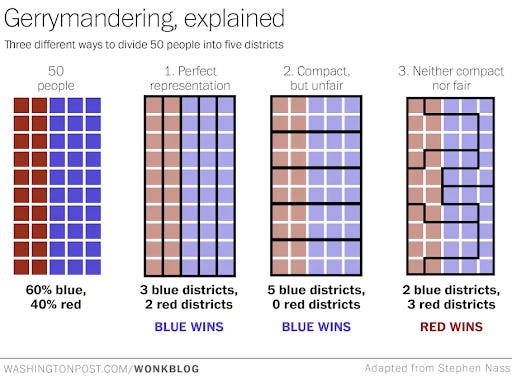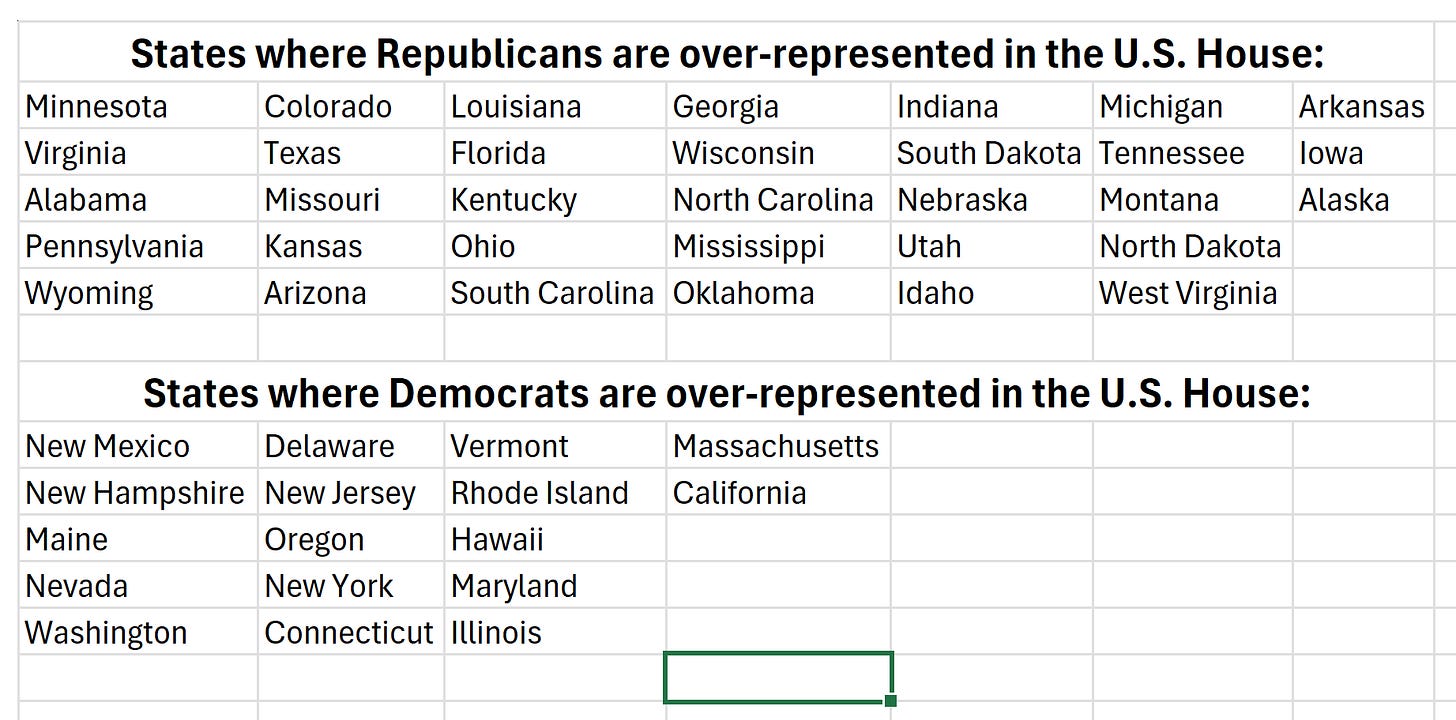Gerrymandering Jubilee
This week is Geography Awareness Week and today is GIS Day! The American Association of Geographers (AAG), the country’s largest academic and professional organization for geographers, will match donations made this week. Donate here.
In honor of Geography Awareness Week, and in light of the recent Texas court ruling that declared the state’s mid-decade redistricting plan “illegal racial gerrymandering,” I thought it prudent to take a look at where the United States stands on all the new maps being drawn.
First, let’s address the rise in unaffiliated voters.
In 2000, unaffiliated voters made up 23% of those registered. Today, that number is 32%. And it varies across widely across the country— from 9% in Alabama to 65% in Massachusetts1.
Four states (Massachusetts, Alaska, Colorado and Rhode Island) have more unaffiliated voters than they do all party members combined.
And it's difficult to tell how those unaffiliated voters split in federal elections. To get a better idea of how the state’s unaffiliated lean, we have to consider turnout, presidential results, congressional results, statewide elections and state legislature elections.
For example, in Massachusetts, only 8% of registered voters are Republicans, but 36% of voters cast ballots for Trump in 2024. But Republican congressional candidates only received 10% of the vote across the state in that same election. In its state assembly and senate, 83% and 85% of seats belong to Democrats, respectively.
Where does the Democratic Party stand?
There are more Democrats than Republicans in 24 of the 50 states with Congressional districts (excluding DC, Puerto Rico, etc).
There are only four states (Vermont, Washington, Virginia and Maryland) where Democrats make up more than 50% of registered voters, and there are four states (Wyoming, Alabama, Oklahoma and South Dakota) where Republicans are more than 50% of the voters.
However, there are 10,158,451 more registered democrats than republicans nation-wide. Nationwide, however, Republican candidates for the U.S. House received nearly 4 million more votes.
To put to bed a lie repeated by MAGA online:
No, New England does not have “40% Republicans but no representation in Congress.”
First, Maine has a Democratic Senator. If you mean the U.S. House, say the House. Congress means both the House and Senate.
Of the 10,642,335 registered voters in New England’s six states, only 1,778,538 are registered Republicans. That’s 16%, not 40.
Which are the most gerrymandered states?
That depends on what you’re counting. Usually when we’re discussing gerrymandering it’s in the context of race and ethnicity — splitting cities and communities in a way that deprives them of representation.
There’s also partisan gerrymandering, which I’m going to focus on here.
If we measure over-representation as the percent of seats controlled by a party compared to the percent of voters registered to that party, we can assess political gerrymandering.
North Carolina, for example, is one of the 24 states where there are more Democratic voters than Republicans. Yet, 10 of their 14 congressional districts are red. It’s the most pro-Republican gerrymandered blue state in the country.
North Carolina has long been the butt of jokes about gerrymandering because of how blunt the state has been in how they’ve rigged the state.
Among states with a Republican majority who also have more than one congressional seat, these are the 10 most gerrymandered states favoring Republicans (starting with the most GOP over-representation):
Iowa
Arkansas
West Virginia
North Dakota
Montana
Tennessee
Idaho
Utah
Nebraska
Indiana
Oklahoma
Yes, democrats are over-represented in some states, but not nearly to the extent as republicans.
The largest difference between congressional seats and party representation that favors Democrats is New Mexico at 32 points.
Democrats control 3 of 3 (100%) Congressional seats in the democratic-majority state, but republicans make up one-third of the electorate so with three seats, they should have at least one based on party affiliation alone.
Seventeen states have districts drawn that disproportionately benefit democrats, with an average of 20 points in over-representation. Only one of those states has more republicans registered than democrats (New Hampshire, with 29% Democrats, 32% Republican, and 39% no affiliation)
Republicans, however, have gerrymandered 33 states to their favor, including eight states where there are more registered democrats than Republicans, by an average of 41 points in over-representation.
California voters voted 2:1 to allow the state to redraw its congressional boundaries this month, whereas several Republican-controlled states began redrawing the districts without the consent of the public.
What’s next for states like Texas, Florida, and others is unclear. It’s unclear if Prop 50, the measure passed by California, will be successful because of the popular vote.
What is clear is this: gerrymandering is wrong no matter who does it.
And that’s why geography matters.
The registration data used for this article is current as of August 2025, and I’m using the current congressional session.
Michigan does not register voters with a party; Kentucky does not allow voters to register without a party.





Loved your post and highlighting the role of maps in social justice.
Would you like to do a podcast interview on Digital Politics https://digitalpoliticsradio.com/ about this topic?
Deepak
deepak@thedemlabs.org